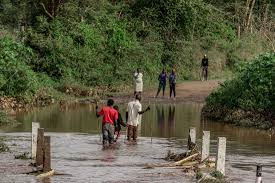PBS: Escaping Eritrea … [Read More...] about ካብ ውሽጢ ቤት ማእሰርታት ኤርትራ
Kenya Is Building Dams to End Its Cycle of Floods and Drought
David Herbling, Samuel Gebre and Fred Ojambo | 31 May, 2020 | Bloomberg News

Plagued by alternating floods and droughts partly brought on by changing weather patterns, Kenya’s government plans to build several new dams in a bid to improve water security and management in the East African nation.
The National Treasury is expected to approve the development of the $868 million Magwagwa multipurpose dam in the west of the country, according to Raymond Omollo, the chief executive officer of the Lake Basin Development Authority.
The dam, 95 meters high and 450 meters long, will be filled using water sources that normally flow into Lake Victoria, which lies at an intersection of the Kenyan, Ugandan and Tanzanian borders, and will be used to generate 120 megawatts of hydropower, he said in a phone interview.
The construction of the Koru-Soin dam, at an estimated 40 billion shillings ($375 million), will start soon and is planned to supply water to the western Kenya counties of Kisumu and Kericho, the Star newspaper reported March 12. From July, the government will accelerate a program to build other dams and increase water-harvesting in the semi-arid north of the country. Proposals to build embankments to prevent flooding on several rivers are also under consideration.
Record Outflow
Flooding caused by unusually heavy downpours have claimed the lives of more than 200 people and displaced at least 100,000 in Kenya this year. President Uhuru Kenyatta has committed his government to spending at least 5 billion shillings on repairing roads and bridges damaged by the rains, and measures to minimize future flooding.
In contrast, part of last year was unusually dry and a drought left more than 1.5 million people in Kenya in need of food aid.
Water levels in Lake Victoria, Africa’s largest lake, rose to the highest in more than 50 years on May 21, while Lake Kyoga which lies downstream in Uganda filled to a record high. The two water bodies are part of Africa’s Great Lakes system, which spans six countries.
Uganda battled to remove a weed mass, as big as a small island, from Lake Victoria after it floated toward a dam and disrupted hydropower production in April. The weed mass moved even after authorities opened up gates from the lake in the eastern Uganda district of Jinja in February, spilling enough water to fill an Olympic-size swimming pool every six seconds, to safeguard the dam’s walls and power infrastructure.
The heavy rainfall has been partly attributed to a 1.2 degree centigrade rise in temperature in the western Indian Ocean over the past century. The phenomenon may have also contributed to creating ideal breeding conditions for desert locusts that have recently staged the worst invasion in parts of Africa and the Middle East in decades and placed food security at risk.
East Africa is likely to experience severe weather events biennially — twice as often as it has over the past four decades — if temperatures persistently exceed historical-average increases of 1 degree centigrade, according to Mubarak Salih Babiker, a climate scientist at the Intergovernmental Authority on Development’s Climate Prediction and Applications Centre, which does research and monitoring in 11 African countries.
“The most dangerous part of climate change is that these kinds of extreme events bring other ecological and environmental extremes such as desert locusts, pests and diseases,” Babiker said. Governments need to prepare for more floods, droughts and pests in future, he said.
